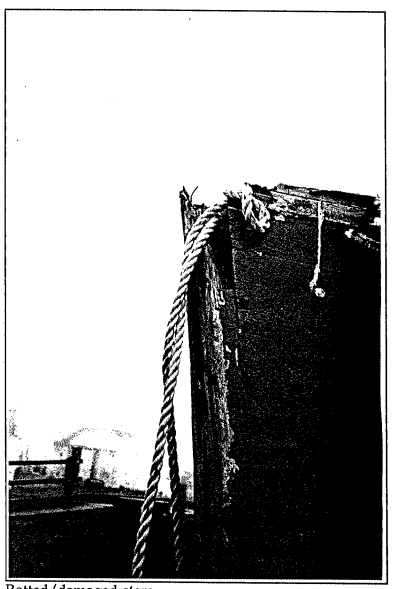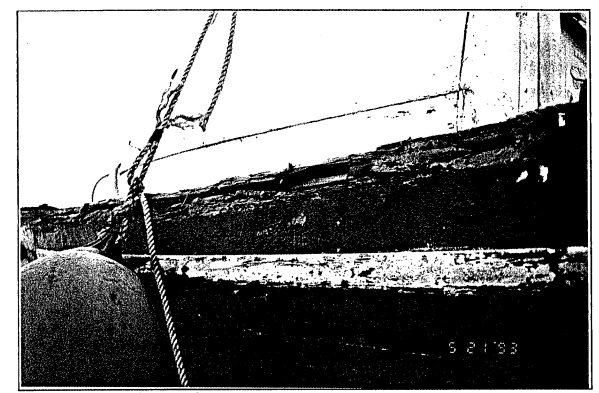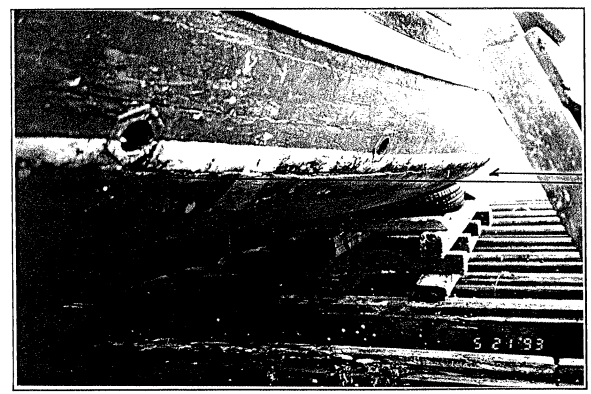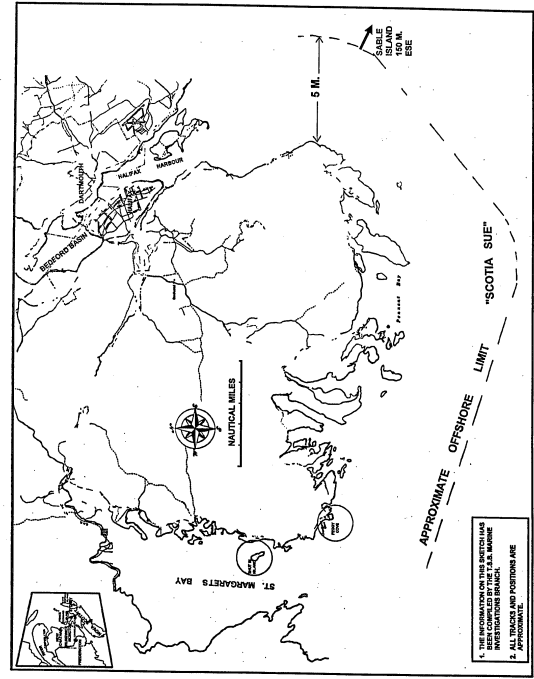Sinking
of the Fishing Vessel "SCOTIA SUE"
at her berth in Halifax, Nova Scotia
The Transportation Safety Board of Canada (TSB) investigated this occurrence for the purpose of advancing transportation safety. It is not the function of the Board to assign fault or determine civil or criminal liability. This report is not created for use in the context of legal, disciplinary or other proceedings. See Ownership and use of content. Masculine pronouns and position titles may be used to signify all genders to comply with the Canadian Transportation Accident Investigation and Safety Board Act (S.C. 1989, c. 3).
Summary
The "SCOTIA SUE" flooded and sank to the bulwarks at her berth. No one was on board. Until the end of the 1992 season, the 25-year-old vessel had been used to take tourists and others for sightseeing trips in and around Halifax Harbour, Nova Scotia.
The Board determined that the uninspected "SCOTIA SUE" sank because the hull was in a deteriorated condition, a sprung plank in the hull caused an ingress of water, and power to the automatic bilge pump was disconnected.
1.0 Factual Information
1.1 Particulars of the Vessel
| "SCOTIA SUE" | |
|---|---|
| Official Number | 330243 |
| Registry | Port of Barrington Passage, Nova Scotia |
| Type | Cape Islander |
| Gross Tons Footnote 1 | 13.8 |
| Length | 10.7 m |
| Built | 1969 |
| Propulsion | 218 kW Footnote 2 motor |
| Owner | Mr. Elliot C. Richard Halifax, Nova Scotia |
1.1.1 Description of the Vessel
The "SCOTIA SUE" is of Cape Island "open boat" design, originally used in the inshore fishing industry. (See photographs at Appendix A.) She was purchased by the present owner in 1986 and has since been used in the tour/charter/passenger/ fishing trips trade in and around the Halifax area.
The timber hull is of carvel construction and the wheel-house is built mainly of plywood.
1 Units of measurement in this report conform to International Maritime Organization (IMO) standards or, where there is no such standard, are expressed in the International System (SI) of units.
2 See Glossary for all abbreviations and acronyms.
1.2 The Occurrence
On the morning of 18 May 1993, the "SCOTIA SUE" was discovered awash to the bulwarks alongside her berth in Halifax Harbour. It was later found that the shore electrical supply to the vessel's bilge pump had been disconnected. The vessel was not in service and there was no one aboard.
1.3 "SCOTIA SUE" - General Condition
It was found that the stem was heavily rotted and damaged as were parts of the deck and the sheer strake.
1.4 Bilge Pumping Arrangement
To ensure that the bilge was regularly pumped out, the owner arranged electrical power from a shore connection to an automatic bilge pump in the engine compartment. The capacity of the bilge pump was stated by the owner to be 124 L/min.
During the night of 17 May to 18 May, the electrical supply cable was disconnected by person(s) unknown.
1.5 Source of the Ingress of Water
The "SCOTIA SUE" was hauled out of the water. The source of the ingress was found to be in the strake immediately below the scuppers, on the starboard side, in the wind and water area. A plank was found to have sprung over a length of approximately 4.3 m.
1.6 Life-saving Appliances
The vessel was equipped with a 10-person liferaft, 2 lifebuoys and 22 lifejackets.
1.7 Canadian Coast Guard Ship Safety Branch - Steamship Inspection Certificate (SIC 16)
The last inspection carried out by the Canadian Coast Guard (CCG) Ship Safety Branch confirmed that the "SCOTIA SUE" was a vessel to which the Safety Convention did not apply, "plying as a passenger ship on voyages not beyond Home Trade, Class IV." The owner did not apply to the CCG for reinspection of his vessel after 30 September 1991.
1.8 Voyage Limits
The vessel's last inspection certificate was dated 08 July 1991; it had expired on 30 September 1991. The certificate limited the vessel's voyages to "Halifax Harbour, Bedford Basin, Northwest Arm and between Shut In Island and Peggy's Cove not more than 5 miles from land in fine weather only." (See chartlet of the occurrence area at Appendix B.)
In a Nova Scotia Tourism & Culture publication, the owner advertises "trips to Sable Island, operating year round."
1.9 Operating Procedures
In 1991, the vessel, which had been in operation since 1986, carried approximately 1,500 passengers and, in 1992, approximately 750. Some 45 to 50 per cent of these passengers were transported under charter agreements, mainly for fishing and sightseeing trips.
Currently, there are no Canadian regulations applicable to charter vessels, but regulations do exist for passenger vessels operating for hire and carrying more than 12 people.
The "SCOTIA SUE" was permitted to carry 18 passengers by her SIC 16, but the vessel's owner had voluntarily reduced this number to 12.
1.10 Operator's Qualifications
The owner, who often had the conduct of the vessel, had no valid Certificate of Competency and had received no formal Marine Emergency Duties training. On other occasions, the vessel was used in passenger-carrying trades with another uncertificated person in charge.
1.11 Charter Vessels
Concerned about the safe operation of some "charter vessels", the CCG Ship Safety Branch issued an Information Paper regarding Charter Vessels on 27 October 1986, which was presented to the Marine Safety Advisory Council.
On 19 June 1987, the CCG Ship Safety Branch issued Ship Safety Bulletin (SSB) No. 7/87 to clarify the application and implementation of the Passenger Vessel Compliance Program (PVCP) discussed in the Information Paper. The PVCP is intended for vessels characterizing themselves as pleasure craft, fishing or other types of vessel, but which are in fact carrying passengers and purport to be "charter vessels."
On 23 November 1988, the CCG Ship Safety Branch issued SSB No. 17/88 to replace SSB No. 7/87. This later document was to assist owners of small passenger vessels to meet the requirements of the PVCP and to bring "charter vessels" into compliance with the Canada Shipping Act (CSA) as passenger ships.
On 25 January 1990, the CCG Ship Safety Branch issued SSB No. 2/90 to replace SSB No. 17/88. The bulletin advised that the PVCP three-year phase to upgrade vessels and the certification of crews terminated, as planned, on 31 December 1989. The bulletin also announced that regulations regarding these passenger vessels and the number of passengers carried, the class of voyage, etc., were in the drafting stage.
These regulations have not been promulgated.
1.12 Charter Vessel Owners Voluntary Association
The owner of the "SCOTIA SUE" is a member of a voluntary association, some of the goals of which are charter vessel registration and Canadian Steamship Inspection. However, the membership has not yet reached a consensus on agreed standards or on the approach the association should take to the CCG Ship Safety Branch. Under existing legislation, these vessels are only inspected upon request from the owners; therefore, the CCG has not initiated any action to inspect such vessels or to ascertain the operators' qualifications.
2.0 Analysis
2.1 Charter Vessels
While unrelated to the circumstances of the occurrence, the analysis focuses on the safety of the public on "charter" vessels.
2.2 Charter Vessel Versus Passenger Vessel
As a "charter vessel" is not defined under the CSA, the ambiguity of the CSA and existing regulations allows for the operation of "charter" vessels carrying passengers for remuneration because they are not classified by their owners as passenger ships.
Some owners in Canada purport that their vessels are "charter vessels" but, in doing so, are operating outside the law regarding inspection of their vessels and certification of crews as required by the CSA and regulations for passenger operations.
Like many other similar operators in Canada, the owner of the "SCOTIA SUE" "charters" this and other non-purpose built vessels to the public for fishing and sightseeing trips. The "SCOTIA SUE" carried a total of approximately 2,250 persons in 1991 and 1992; however, for 1992, the vessel did not have an inspection certificate.
The onus rests with the owner to have a vessel inspected, but many owners believe that a higher standard may be required to obtain an inspection certificate. Inspection, construction, and crewing standards are much more rigorous for a designated passenger vessel. Many owners feel that, in the current economic climate, they are unable to afford the greater expense involved.
At present, there is no legal requirement for the owner of the "SCOTIA SUE" to request a CCG Ship Safety Branch inspection of his vessel for a bona fide charter operation.
2.3 "SCOTIA SUE" - General Condition
The extent of the rot in the vessel was such that it must have been an existing condition when the vessel was last inspected by the CCG Ship Safety Branch. However, at the time the vessel was salvaged, the paint finish on the vessel superficially covered this damage and made it less apparent.
2.4 Source of the Ingress of Water
While there may have been other minor sources of leakage, the main source of ingress was the sprung plank. (See Section 1.5.)
2.5 Partial Sinking of the Vessel
The vessel's fuel tanks were nearly empty and the lifejackets, lifebuoys and storage chests were stored in the cuddy. The reserve buoyancy of these items plus the "lift" of the mooring lines prevented the vessel from sinking completely.
3.0 Findings
- The "SCOTIA SUE" sank to the bulwarks at her berth during a period when she had no crew on board.
- The source of the ingress of water was found to be a sprung plank, on the vessel's starboard side, in the wind and water area.
- The vessel, which was heavily rotted in several areas, had last been inspected by the Canadian Coast Guard (CCG) in July 1991.
- During the night of 17 May to 18 May, when the vessel was unattended, the shore electrical supply cable was disconnected by unknown means.
- The shore-powered automatic bilge pump ceased to function when power was cut off.
- The vessel was prevented from sinking completely because of the reserve buoyancy of nearly empty fuel tanks, the lifejackets, lifebuoys and storage chests in the cuddy and the lift of her mooring lines.
- There is no specific definition of a "charter vessel" in the Canada Shipping Act.
- The vessel's owner did not request that the "SCOTIA SUE" be inspected by the CCG Ship Safety Branch upon the expiry of the vessel's Steamship Inspection Certificate on 30 September 1991.
- The "SCOTIA SUE" carried passengers during the summer of 1992 without an Inspection Certificate issued by a Steamship Inspector.
- The vessel is certificated to operate during the summer season within clearly defined limits in Halifax Harbour; however, the owner advertises "trips to Sable Island, operating year round" in the Nova Scotia Tourism & Culture publication.
3.1 Causes and contributing factors
The uninspected "SCOTIA SUE" sank because the hull was in a deteriorated condition, a sprung plank in the hull caused an ingress of water, and power to the automatic bilge pump was disconnected.
4.0 Safety Action
4.1 Safety Action Taken
4.1.1 Removal from Service
Following the accident, the vessel was slipped for inspection. Several frames were exposed on the starboard side of the vessel, some of which were severely rotted and wasted. The vessel was consequently taken out of service.
4.1.2 "Charter" and/or "Passenger" Vessels
Within the tour boat industry, small wooden vessels are offered for charter, fishing and sightseeing trips and are often without qualified operators. Since there is no specific definition of a "charter vessel" in the Canada Shipping Act (CSA), some owners claim that their vessels are on charter when in fact they are carrying fare-paying passengers. They therefore believe that they are not subject to inspections of their vessels and certification of their crews. Notwithstanding the fact that there are no Canadian regulations applicable to charter vessels, regulations do exist for passenger vessels operating for hire and carrying more than 12 people.
Recent marine occurrences have drawn the Board's attention to shortcomings with respect to the CSA regulations and the operational practices of charter operators. In February 1994, the Board issued five safety recommendations dealing with charter vessels and the circumvention of safety regulations. Inter alia, the Board recommended that:
The Department of Transport conduct a formal safety evaluation of the Canadian charter boat industry to include the adequacy of vessel inspection and crew certification requirements as well as current operational practices; and
Transportation Safety Recommendation M94-01(issued February 1994)
The Department of Transport expedite its currently proposed amendment to the Canada Shipping Act with respect to the carriage of the fare-paying public as passengers on charter vessels.
Transportation Safety Recommendation M94-02(issued February 1994)
In its reply, the Department of Transport indicated that, following regional consultations, held in April, and an interdepartmental meeting, held in May 1994, the Department has started its revision of the Passenger Vessel Regulations, and appropriate amendments are presently within the legislative process. The proposed amendments would bring "charter" vessels within the application of the legislation as passenger vessels. Furthermore, the Canadian Coast Guard (CCG) has formed a working group to produce a policy document on charter vessel operations and safety. In addition, the CCG has engaged an independant consultant group to conduct a formal safety evaluation of the Canadian charter boat industry.
Moreover, a recent Quebec court ruling concerning a charter vessel has given CCG ship inspectors legal authority to board any vessel, inspected or non-inspected, including charter vessels, for safety reasons.
4.1.3 Non-certificated Passenger-carrying Vessels
In November 1986, the CCG introduced the "Passenger Vessel Compliance Program" (PVCP) to give the operators of passenger vessels and bona fide charter vessels a three-year period in which to upgrade their vessels and their crews' certification. Under this program, if so requested by the owners, the CCG would conduct a survey to determine compliance with passenger vessel regulations.
Approximately 130 vessels were brought into compliance with the regulations, and the program was terminated on 31 December 1989. To encourage voluntary compliance, the CCG distributed highly visible plastic placards across the country, advising potential passengers to ensure that the vessels on which they travel are in compliance with the regulations and/or have valid inspection certificates.
Following a fatal occurrence involving a passenger-carrying barge (TSB report no. M92W1081), a TSB Marine Safety Advisory (MSA no. 26/92) was forwarded to the CCG with a view to improving verification and inspection procedures for passenger-carrying vessels. Although the barge was not suitably equipped or certificated to carry passengers, it had carried passengers regularly for several years up to the time of the accident. In response to the MSA, the CCG indicated that it relies on local authorities and private citizens for information concerning uncertified operations.
This report concludes the Transportation Safety Board's investigation into this occurrence. Consequently, the Board, consisting of Chairperson, John W. Stants, and members Zita Brunet and Hugh MacNeil, authorized the release of this report on .
Appendices
Appendix A - Photographs
Appendix B - Chartlet of the Occurrence Area
Appendix C - Glossary
- CCG
- Canadian Coast Guard
- CSA
- Canada Shipping Act
- IMO
- International Maritime Organization
- L/min
- litre(s) per minute
- L/min
- litre(s) per minute
- kW
- kilowatt(s)
- m
- metre(s)
- PVCP
- Passenger Vessel Compliance Program
- reserve buoyancy
- In this case, the flotation provided to the vessel because of lifejackets, etc., in enclosed spaces.
- scuppers
- Drain pipes located on weather decks designed to drain accumulations of rain, washdown or shipped water overboard.
- SI
- International System (of units)
- SSB
- Ship Safety Bulletin
- strake
- A range of planks or plates abutting against each other and extending the whole length of the ship.
- sheer strake
- Strake of shell planking or plating running next to the main or strength deck.
- TSB
- Transportation Safety Board of Canada






